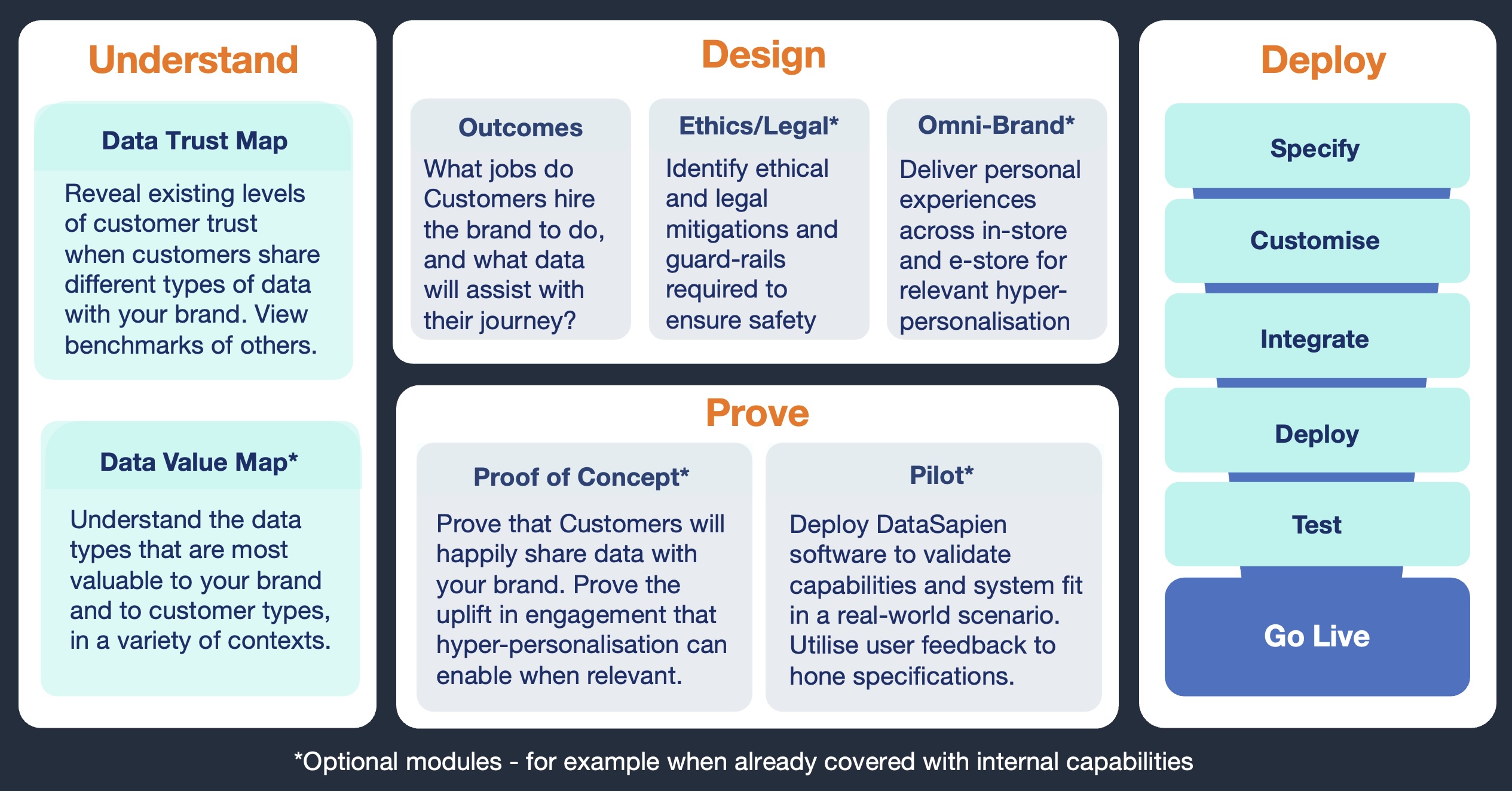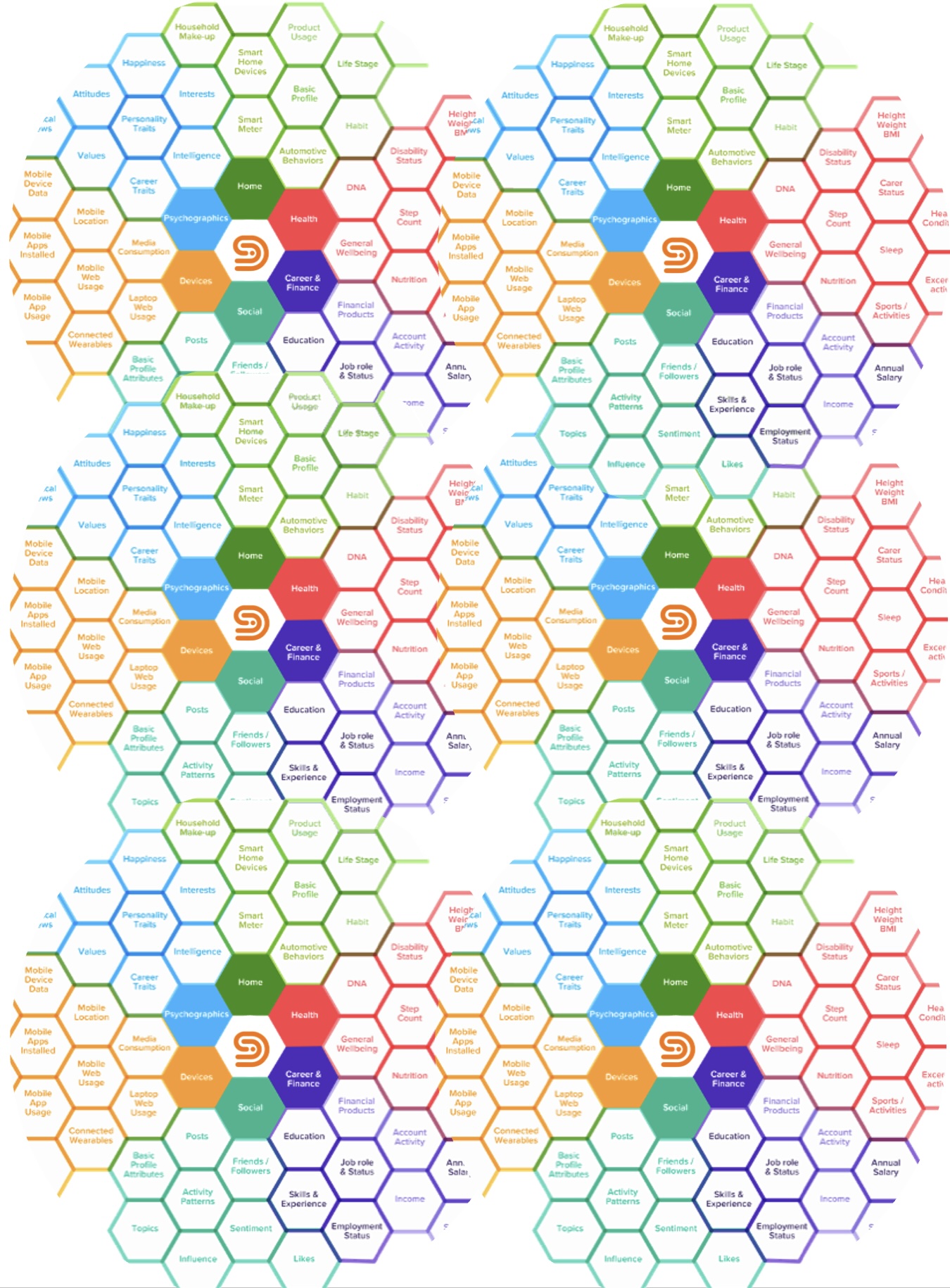Engage With Us
Easy Steps to Powerful Private Personalisation
Consumer brands will thrive by empowering their customers with their own data. The secret to accentuating success is knowledge. Our modular approach to discovery, design, validation and deployment is designed to mitigate risks and maximise the value of rolling out DataSapien technology.
This marks a major shift in customer marketing and the future of customer engagement meets cutting-edge technology and innovative strategies.
As you embark on a journey with us, discover the multitude of ways we can revolutionise how you connect with your customers. Let’s explore together how DataSapien can elevate your brand through our unique engagement models:
Paths to Succesful Deployment
We offer carefully created discovery, design and validation modules that enable you to build your knowledge and ensure the deployment of DataSapien technology maximises outcomes for your brand and your customers.
The modules are designed to be combined to create the flow of knowledge tailored to your organisation’s specific needs. We partner with leading experts who have worked with the world’s largest brands in each domain.

Understand
1) Data Trust Map
What trust has your brand earned to when dealing with customers and their data? What types of data will your customers grant you permission to ask for? What types of data requests will create concern, distrust and disengagement?
We recommend to all clients that they start with a data permission mapping exercise to understand where they are today and create a baseline for tomorrow’s actions.
2) Data Value Map
What types of data are most valuable to your organisation and why? What types of data do your customers perceive to be most and least valuable to them?
Understanding perceptions of data value provides an essential input to designing data-driven services that are trusted to solve the jobs that customers hire the brand to perform for them.

Design
a 1) Jobs To Be Done (JTBD)
What jobs do Customers hire the brand to do, and what data will assist with their journey?
Design the personalised flows that solve for customer wants and needs in the context of their every-day lives.
2) Ethics/Legal
Identify legal, ethical and moral risks and harms to formulate, design and mitigations. These activities provide the guard-rails required to ensure the safe operation of the service for the customer and the brand.
3) Omni-Branding
Deliver personalised brand experiences across in-store and e-store for relevant hyper-personalisation that makes absolute sense to the customer in the context of the job that they are seeking to get done.
How do the brands in-store digital interactions integrate with the e-commerce experience?
Prove
1) Proof of Concept
Personal data participation drives powerful outcomes but makes several assumptions. These activities validate assumptions in the context of a brand’s own customers – to, for example:
- Prove that Customers will happily share data with your brand.
- Prove the uplift in engagement that hyper-personalisation can enable when relevant.
Proof of Concept projects are run with real customers via a partner platform that offers private and anonymised data interactions.
2) Pilot
Deploy DataSapien software on a small scale to:
- Measure interactions, validate capabilities and ensure system fit in a real-world scenario.
- Identify and address any issues before a full rollout.
- Opportunity for the end-users and IT staff to get familiar with the software, providing valuable training and adjustment time without the pressure of a company-wide launch.
- Better understand the cost implications and the potential ROI of the software, aiding in financial planning and budgeting.
- Showcase the benefits to internal stakeholders and mitigate any fears or concerns about the new system.
- Confirm the scalability of the solution, ensuring that it can handle the full scope of their operations when fully implemented
- Utilise user feedback to hone specifications.
A pilot program can be a prudent step toward full adoption, providing a controlled environment to evaluate impact, utility, and return on investment before committing resources to the full rollout.

Deploy
The DataSapien team has cumulative decades of experience in rolling out enterprise software to major enterprises. We also partner with leading consultancies and system integrators to provide additional ‘bench depth’ and customer-specific expertise.
- Specify: Define the specific requirements and objectives that the DataSapien software must meet, ensuring it aligns with your business’s needs and workflows in serving your customers.
- Customise: Tailor the software to fit the unique processes and preferences of your organisation, involving adjustments to the software’s functionality, interface, and experience to meet the specified requirements. Customisation may also include the creation of new data types, insights, algorithms and API connections.
- Integrate: DataSapien software is connected with other systems and applications the business uses, allowing for seamless data flow and functionality across your organisation’s technological ecosystem.
- Deploy: This is the process of installing and setting up the software in your organisation’s operational environment, making it ready for use by the end-users.
- Test: Before going live, thorough testing is conducted to identify and rectify any bugs, issues, or inefficiencies, ensuring the DataSapien software operates as intended under various scenarios.
- Go-Live: The software is officially put into operation and made accessible to all users, marking the transition from a development and preparation phase to actual use in the business’s day-to-day activities.
- Maintain & Expand: Post-deployment, DataSapien software undergoes regular maintenance to address any emerging issues, and updates or expansions are implemented to enhance functionality and keep the software aligned with the evolving needs of your business.
